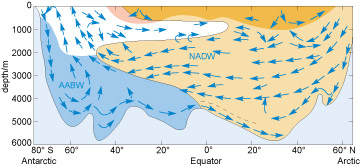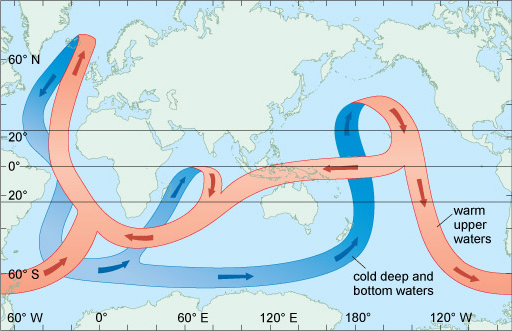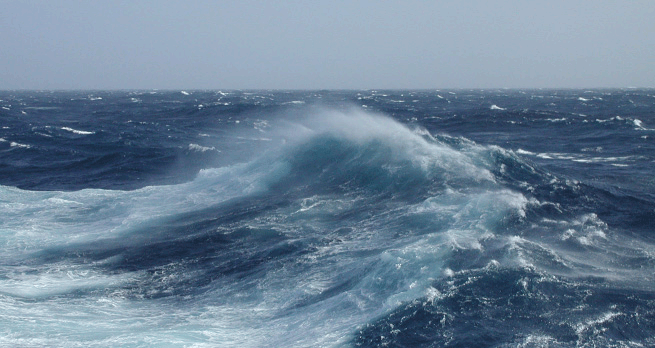4.7 The global ocean circulation
As seawater freezes and ice is formed in the annual cycles you saw in Activity 2, salt is squeezed from between the ice crystals into the ocean beneath in a process called salt rejection. The result is that if you took one pancake ice floe (Figure 21b) and melted it in a bucket, the water that resulted would be fresher than the seawater you started with. So what has happened to the salt?
The answer is it has increased the density of the seawater just beneath the ice. This is a small-scale physical process, but the effects are global and profound, as is clear from Figure 13. Salt rejection from sea ice generation in the Antarctic creates dense water which sinks and floods away from the continent. The coldest water is not the most saline; it is the combination of the cold temperatures and increased salinity that makes the water dense enough to sink to the sea floor.
The very large volume of water of uniform temperature and salinity flooding away from Antarctica is called Antarctic Bottom Water (AABW) because it is formed in the Antarctic and is dense enough to reach the bottom of the ocean and flow away from the continent. The lowest-salinity water at ~1000 m depth and ~40° S, coloured purple and blue in Figure 13, is formed by the climatic conditions in the mid-latitudes of the Southern Hemisphere and is not as dense as AABW.
You have investigated a section through the Atlantic Ocean, but had you looked at any section radiating from Antarctica along a particular longitude, the picture would have been broadly similar. The sea ice generation and resulting salt rejection is driving a cold, relatively salty, dense water current northwards along the sea floor at great depth.
If a deep, cold, salty current is flowing away at depth, there has to be water flowing towards Antarctica to replace it. Arctic salt rejection increases the density of the waters at the other end of the planet but, because of the shallow sea floor between Greenland, Iceland and the UK, the densest water is contained and cannot flow south. What can escape into the North Atlantic sinks to the sea floor, and so is called North Atlantic Deep Water (NADW). The resulting picture of ocean circulation in the Atlantic when these water masses meet is shown in Figure 23.

The dense AABW (coloured blue) spreads northwards along the sea floor and the NADW (brown) spreads south.
-
Based on Figure 23, which water mass is denser, AABW or NADW?
-
The NADW flows over the AABW so it must be less dense.
Figure 24 shows that NADW is both warmer and more saline than AABW, so it is less dense (Figure 23). However, the NADW is denser than the water mass coloured white and consequently is sandwiched between this and the AABW.
The actual boundaries between the layers are not as distinct as the colours in the picture would suggest, but overall there is an overturning circulation along the length of the Atlantic Ocean. In the Pacific and Indian Oceans the picture would be similar to Figure 23 south of the Equator, but the northern end would be different.
The Indian Ocean does not reach the Arctic, and in the Pacific Ocean, as you have seen, the gap between Asia and North America is so narrow and shallow that the ocean is virtually closed off to the north. This means that virtually all of the deep waters formed in the Arctic enter the global ocean in the North Atlantic. The result is a vast three-dimensional circulation across the entire global ocean called the thermohaline circulation ('thermohaline' meaning heat and salt) (Figure 24). This was proposed in the 1980s by American climate scientist Wallace Broecker. It is often referred to as the 'conveyor belt'.

Figure 24 is of course a gross simplification, but it is useful to help you think about the way the global ocean circulates over hundreds of years. It makes clear that polar processes such as the sea ice growth can drive the global ocean circulation and move vast quantities of heat and salt around the planet. Ultimately it is these processes that are responsible for the sea surface temperature distribution you saw in Figure 1, making the UK and Norway warmer than locations at similar latitudes on the west side of the Atlantic.
-
What could be the effect of reduced deep-water formation in the North Atlantic Ocean on the climate of Western Europe?
-
Reduced deep-water formation in the North Atlantic could decrease the strength of the deep branch of the oceanic 'conveyor belt' in Figure 15. This could reduce the strength of the whole conveyor belt and so less heat would be carried from the Pacific Ocean into the Atlantic Ocean. Ultimately, it could lead to cooling of the climate of Western Europe.
Activity 3 The circulation of the oceans
Part 1: Ocean models
You are probably familiar with meteorological agencies such as the United Kingdom Meteorological Office (UKMO) using computer models to predict the weather. The models they use are 'coupled' models, with a model of the atmosphere and a model of the oceans passing data between them, which increases the accuracy of their predictions.
The latest high-resolution computer models need large computers to run them, and the results are both impressive and beautiful to watch. One large ocean model is called ECCO2, which stands for Estimating the Circulation and Climate of the Ocean, Phase II. It is easy to think of the ocean having a rather simplistic circulation pattern such as that shown in Figure 15, but that is only because it is hard to observe.
Video 10 shows modelled oceanic surface currents from June 2005 through to December 2007. Dark patterns under the ocean represent the undersea bathymetry. The land topography is exaggerated 20 times and the bathymetry is exaggerated by 40 times. When you have watched the clip, try to answer the questions below.
Question 1
What is the most surprising thing about the flow of water around the coast of South Africa?
Answer
From 37 seconds onwards in the clip you can see that, instead of a continuous flow of water, there are discrete, rapidly rotating patterns of closed circulation. These are called ocean eddies, and if you saw these patterns on a weather map you would call them storms.
Question 2
Is the strength of the currents the same on both sides of the northern Pacific and Atlantic oceans?
Answer
No, the current is stronger on the western side of each of these great oceans. These currents are called western boundary currents and they include the Gulf Stream and the Kuroshio. There are also western boundary currents in the Southern Hemisphere, but they rotate in the opposite direction.
Question 3
The previous video showed the surface currents. From the same ocean model Video 11 shows the sea surface temperature and the modelled sea ice concentration. What you will observe is the annual cycle of temperatures over several years. Note the difference in North Atlantic temperatures either side of the basin that was pointed out in Figure 1
Can you identify the western boundary currents and the ocean eddies around South Africa that were so clear in the previous video?
Answer
It is possible to see both of those features, although they are perhaps not as clear as in the previous visualisation.
Part 2: The thermohaline circulation
Video 12 shows an animation of the schematic thermohaline circulation shown in Figure 24. It is important to note that this animation is purely on our understanding of the global ocean circulation rather than model output like in the previous two videos. It is also important to remember that one complete circulation would take several hundred years.
The shading on the beginning of the animation represents water density. Bright regions are less dense shallow currents and lighter arrows are dense and deep currents. The depths of the oceans and land topography are highly exaggerated (100× in oceans, 20× on land) so that the depth differences in the currents show up more clearly. When you have seen the video, try to answer the questions before.
Question 4
Between Greenland, Iceland and Scotland, is the densest current flowing southwards in the location of the deepest channel you identified in Activity 1?
Answer
Yes, the densest current is flowing southwards just north of Scotland.
Question 5
In the western boundary current of the North Atlantic (the Gulf Stream), is the thermohaline circulation in the same direction at all depths?
Answer
No. It is only the surface waters that are flowing northeastwards towards Europe; at depth the waters are flowing in the opposite direction.
Question 6
In the previous videos you saw that the flow of water around South Africa appeared in the computer model output as a constant stream of eddies. How does this flow appear in the thermohaline circulation?
Answer
The constant stream of eddies around the coast is represented as a continuous flow of less dense water.
Question 7
What is the main difference between the representations of the flow of water around Antarctica in Figure 24 (above) and this video?
Answer
Figure 24 does not show a continuous clockwise circulation around Antarctica (the Antarctic Circumpolar Current - see Section 4.1), like the animation or the previous model output in this activity.
In this activity you have seen just how complex and beautiful the ocean circulation is.
